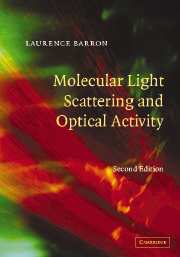Book contents
- Frontmatter
- Contents
- Preface to the first edition
- Preface to the second edition
- List of symbols
- 1 A historical review of optical activity phenomena
- 2 Molecules in electric and magnetic fields
- 3 Molecular scattering of polarized light
- 4 Symmetry and optical activity
- 5 Natural electronic optical activity
- 6 Magnetic electronic optical activity
- 7 Natural vibrational optical activity
- 8 Antisymmetric scattering and magnetic Raman optical activity
- References
- Index
8 - Antisymmetric scattering and magnetic Raman optical activity
Published online by Cambridge University Press: 07 August 2009
- Frontmatter
- Contents
- Preface to the first edition
- Preface to the second edition
- List of symbols
- 1 A historical review of optical activity phenomena
- 2 Molecules in electric and magnetic fields
- 3 Molecular scattering of polarized light
- 4 Symmetry and optical activity
- 5 Natural electronic optical activity
- 6 Magnetic electronic optical activity
- 7 Natural vibrational optical activity
- 8 Antisymmetric scattering and magnetic Raman optical activity
- References
- Index
Summary
If you think that I have got hold of something here please keep it to yourself. I do not want some lousy Englishman to steal the idea. And it will take a long time to get it into shape.
Friedrich Engels (in a letter to Marx)Introduction
Antisymmetric matter tensors have been important for many years in connection with linear magneto–optical phenomena such as the Faraday effect. But until recently, Rayleigh and Raman scattering of light through antisymmetric tensors remained something of a minor curiosity, the only examples being in Rayleigh scattering from vapours of atoms such as sodium in spin degenerate ground states (Placzek, 1934; Penney, 1969; Tam and Au, 1976; Hamaguchi, Buckingham and Kakimoto, 1980). As discussed in Section 3.5.3, pure antisymmetric Rayleigh and Raman scattering is characterized by inverse polarization and its presence is usually detected via ‘anomalies’ in the depolarization ratio: estimates of the relative contributions of symmetric and antisymmetric scattering in a particular band require a set of complete polarization measurements that include the reversal coefficient in backscattering of circularly polarized light.
Antisymmetric scattering came to prominence with the observation by Spiro and Strekas (1972) of almost pure inverse polarization in many of the vibrational bands in the resonance Raman spectra of haem proteins, and antisymmetric scattering was found to dominate the resonance Raman spectra of many metalloporphyrins, at least using incident light at visible wavelengths.
- Type
- Chapter
- Information
- Molecular Light Scattering and Optical Activity , pp. 385 - 422Publisher: Cambridge University PressPrint publication year: 2004



